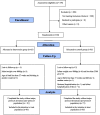Comparing the effects of breastfeeding in the laid-back and cradle position upon the experiences of primiparous women: a parallel randomized clinical trial
- PMID: 36782308
- PMCID: PMC9926697
- DOI: 10.1186/s13063-023-07143-0
Comparing the effects of breastfeeding in the laid-back and cradle position upon the experiences of primiparous women: a parallel randomized clinical trial
Abstract
Background and aim: Appropriate positioning is crucial to successful breastfeeding and its continuation. Positioning can create, prevent, or correct breastfeeding problems. This study aimed to determine and compare the effects of both the laid-back and cradle positions upon the breastfeeding experiences of primiparous (cisgender) women.
Methods: A parallel randomized clinical trial was conducted with a sample of primiparous women (n = 168) with a gestational age of between 31 and 34 weeks, referring to the perinatal clinic of Shahid Gharazi Hospital in Malayer (Hamadan Province, Iran). Participants were recruited via convenience sampling and allocated to one of two groups: intervention (laid-back position) (n = 85) and control (cradle position) (n = 83) using the random block method. Breastfeeding education was given to both groups during two sessions (weeks 31-34 and 35--37 of pregnancy) by "baby-friendly" accredited hospitals in Iran. The intervention group was instructed on how to breastfeed using the laid-back position. The control group was instructed on how to breastfeed using the cradle position. In the immediate postnatal period, breastfeeding positions were assessed in both groups. Breastfeeding experiences were measured once at the time of participants returning home and again at both 1 week and 2 weeks following birth, using the breastfeeding experience scale. Data analysis was undertaken using the SPSS software version 21. A value of P < 0.05 was considered significant.
Results: No statistically significant difference was observed between the two groups in terms of concerns relating to participants nor their breasts, milk insufficiency, neonate, process, or breastfeeding experience at any time point measured. The means (SDs) of breastfeeding experience at the time of discharge, 1 week, and 2 weeks after childbirth in intervention group were 26.07 (4.533), 26.85 (3.812), and 26.65 (4.632) respectively. The means (SDs) of breastfeeding experience at the time of discharge, 1 week, and 2 weeks after childbirth in control group were 25.42 (3.315), 26.68 (3.872), and 25.41 (4.05) respectively.
Conclusion: There is no difference in breastfeeding experiences whether the laid-back or cradle position is used. Thus, broader education on breastfeeding and the provision of comprehensive support may be more effective in optimizing one's experience of breastfeeding.
Trial registration: Registration date: 2021 July 21, Code: IRCT20180427039436N10, https://irct.ir/user/trial/57054/view.
Keywords: Breastfeeding experience; Breastfeeding positions; Cradle position; Laid-back position.
© 2023. The Author(s).
Conflict of interest statement
The authors declare no competing interests.
Figures
Similar articles
-
Breastfeeding outcome comparison by parity.Breastfeed Med. 2015 Apr;10(3):156-62. doi: 10.1089/bfm.2014.0119. Epub 2014 Dec 30. Breastfeed Med. 2015. PMID: 25549051 Free PMC article.
-
Comparison of Cradle Hold Versus Football Hold Breastfeeding Positions after Cesarean Section in Primiparous Mothers.Breastfeed Med. 2021 Nov;16(11):904-908. doi: 10.1089/bfm.2021.0029. Epub 2021 Jun 16. Breastfeed Med. 2021. PMID: 34134521
-
Comparison of Breastfeeding Outcomes Between Using the Laid-Back and Side-Lying Breastfeeding Positions in Mothers Delivering by Cesarean Section: A Randomized Controlled Trial.Breastfeed Med. 2017 May;12:233-237. doi: 10.1089/bfm.2016.0193. Epub 2017 Apr 6. Breastfeed Med. 2017. PMID: 28384091 Clinical Trial.
-
The effectiveness of the laid-back position on lactation-related nipple problems and comfort: a meta-analysis.BMC Pregnancy Childbirth. 2021 Mar 24;21(1):248. doi: 10.1186/s12884-021-03714-8. BMC Pregnancy Childbirth. 2021. PMID: 33761882 Free PMC article.
-
Interventions for supporting the initiation and continuation of breastfeeding among women who are overweight or obese.Cochrane Database Syst Rev. 2019 Sep 17;9(9):CD012099. doi: 10.1002/14651858.CD012099.pub2. Cochrane Database Syst Rev. 2019. PMID: 31529625 Free PMC article.
Cited by
-
Maternal knowledge, attitudes, and practices regarding breastfeeding and mastitis.BMC Pregnancy Childbirth. 2025 Jul 10;25(1):748. doi: 10.1186/s12884-025-07867-8. BMC Pregnancy Childbirth. 2025. PMID: 40640753 Free PMC article.
References
-
- WHO. Breastfeeding. 2018. http://www.who.int/maternal_child_adolescent/topics/child/nutrition/brea.... Accessed 5 Aug 2020.
-
- Bhatia J, Shamir R, Vandenplas Y. Protein in neonatal and infant nutrition: recent updates: 86th Nestlé Nutrition Institute Workshop, Beijing, May 2015: Karger Medical and Scientific Publishers; 2016.
-
- Mosca F, Giannì ML. Human milk: composition and health benefits. 2017. - PubMed
Publication types
MeSH terms
Grants and funding
LinkOut - more resources
Full Text Sources
Medical



